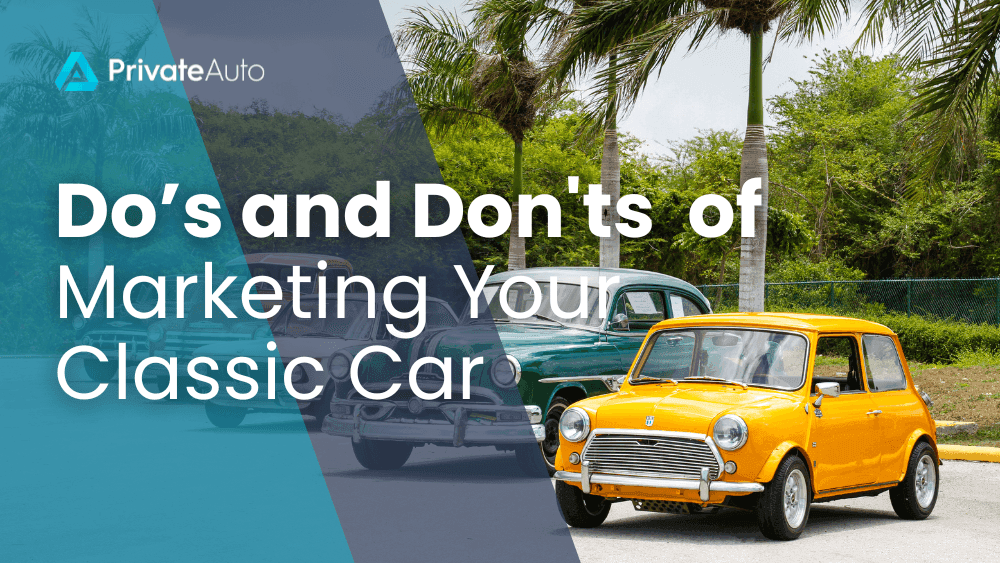Do’s and Don'ts of Marketing Your Classic Car

When it’s time to list your vintage vehicle, don’t make any of these classic mistakes. Classic car marketing should help you quickly connect with a motivated buyer and receive a competitive offer. Review these do’s and don’ts to see how you can avoid common mistakes and enjoy a safe transaction.
Do: Clean Out Your Classic Car
Even the most lovingly restored classic vehicle is going to be a tough sell if it’s full of trash and covered in dirt. Your vintage vehicle shouldn’t look like it’s a college student commuter, so take the time to clean it out and polish the exterior.
If you don’t have the time to do a full detailing project, then take your classic vehicle to a local detailing service. Be sure your chosen company has experience working with classic vehicles to ensure safe cleaning and care.
While you’re cleaning your vehicle, consider the last time you have it serviced. Classic vehicles sell whether they’re drivable or a project car, but a few maintenance tasks can help you get more out of the sale. A recent oil change, brake inspection, and other tune-up steps show you care about your ride.
If you don’t have the time to do a full detailing project, then take your classic vehicle to a local detailing service. Be sure your chosen company has experience working with classic vehicles to ensure safe cleaning and care.
While you’re cleaning your vehicle, consider the last time you have it serviced. Classic vehicles sell whether they’re drivable or a project car, but a few maintenance tasks can help you get more out of the sale. A recent oil change, brake inspection, and other tune-up steps show you care about your ride.
Do: Verify the Make, Model, and Year
Most listing sites allow buyers to search by make, model, and year. Of course, this feature isn’t helpful if you have your car listed incorrectly. Vintage vehicles changed dramatically in price and popularity from year to year, so it’s crucial to enter the correct information on your listing. This will save you time and avoid frustrating buyers looking for a specific ride.
VINs weren’t standardized until 1981, but they’ve been in use since 1954. You can use this number to lookup more information about your classic vehicle. This helps you uncover the year of manufacture and other information you may not know about the family collector car.
VINs weren’t standardized until 1981, but they’ve been in use since 1954. You can use this number to lookup more information about your classic vehicle. This helps you uncover the year of manufacture and other information you may not know about the family collector car.
Do: Price Your Car Correctly
Is your car priced to sell? A competitive price for a vintage vehicle can be difficult to determine if you aren’t familiar with the current market. Use valuation tips and search other listings on a reputable listing site to see how much your car may be worth.
A good price should be low enough to sell quickly but high enough for you to get the money you deserve. Consider ways to improve the value of your used vehicle with maintenance tasks.
A good price should be low enough to sell quickly but high enough for you to get the money you deserve. Consider ways to improve the value of your used vehicle with maintenance tasks.
Don’t: Lie in the Listing
You may think your car’s worth a million bucks, but don’t try to stretch the truth to draw in motivated buyers. Classic car marketing should be based on factual information about the car, not over-inflated promises.
Common lies in listings include the condition of the vehicle, its year, and its engine type. All of these are easy to verify once a buyer sees your car in person, so avoid these deceptions to save time when selling your car.
Common lies in listings include the condition of the vehicle, its year, and its engine type. All of these are easy to verify once a buyer sees your car in person, so avoid these deceptions to save time when selling your car.
Do: Take Professional Photos
Your goal with your listing is to accurately represent your ride. You don’t need to deceive buyers but put your best foot forward with detailed photos. Find a great location and take photos that show your classic vehicle at every angle. Here are some common areas you should show off with your images:
Be sure every exterior photo shows the entire length of your vehicle. A common seller mistake is to cut off the front or rear of the car in an image, which looks unprofessional and may seem like you’re hiding imperfections.
•
Engine compartment
•
Dashboard
•
Seats
•
Exterior front, rear, and side
Do: Create a Detailed Listing
When you write a listing for a classic car, you need to include a wide range of information. You don’t need to write long paragraphs describing how exceptional your car is, but your listing should include this information:
You probably won’t have all the service history for your classic ride, but it's helpful to show proof of recent oil changes and other maintenance tasks. If your classic car has a new engine, lift kit, or other modification, it’s important to highlight any alterations.
•
Year, make and model
•
VIN
•
Mileage
•
Trim level
•
Known modifications
•
OEM vs. aftermarket restoration
•
Any known issues
•
Service history
Don’t: Try to Hide Blemishes
It can be tempting to take photos that hide rust spots, dents, scratches, and other blemishes of your classic vehicle. While social media and online listing sites make it easy to show off your vehicle in the best light, don’t hide known issues as you market your classic ride.
Buyers are going to want to see your vehicle in person and examine it. You can’t hide blemishes in person the same way you can in photos, so there’s no reason to try to deceive buyers at this stage. If you’re self-conscious about a few rust spots and scratches, invest in a body repair service rather than attempting to cover up the damage.
Buyers are going to want to see your vehicle in person and examine it. You can’t hide blemishes in person the same way you can in photos, so there’s no reason to try to deceive buyers at this stage. If you’re self-conscious about a few rust spots and scratches, invest in a body repair service rather than attempting to cover up the damage.
Don’t: Take Photos in a Bad Location
Even the most stunning classic ride looks disheveled if you take photos in a junkyard. Spend some time finding an eye-catching location to take your classic car marketing photos. Avoid any garbage, rusted vehicles, and other debris in the background, as these features can make the car itself feel less valuable.
Don’t: Write a Novel for a Listing
A brief paragraph may help you describe some unusual features of your classic vehicle, but no one wants to read a novel before buying a car. Streamline your listing with bullet points, fast facts, and short sentences.
If you spend too much time talking about your vehicle or adding personal information, it may hide the key facts in your prose. Focus on the features that will sell your vehicle, like its condition and trim level, then use a few sentences to highlight any known damage, modifications, or other unique features.
If you spend too much time talking about your vehicle or adding personal information, it may hide the key facts in your prose. Focus on the features that will sell your vehicle, like its condition and trim level, then use a few sentences to highlight any known damage, modifications, or other unique features.
Do: Choose a Safe Selling Service
The listing service you choose matters. Wrap up your classic car marketing strategy by creating a listing with PrivateAuto. List your vehicle and connect with verified buyers using this self-service solution.



